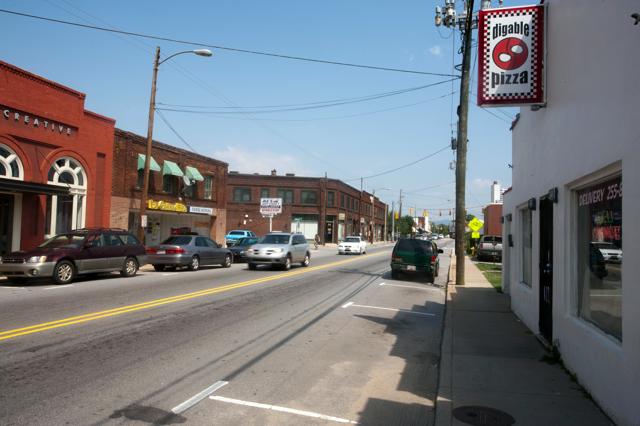- Crime down on Burton Street
- Sulphur Springs pavilion restoration?
It must have been a relief. Just emerged from budget battles and well aware of the rancor that sometimes bubbles up in community meetings, Asheville City Council members had to appreciate their warm reception at the May 31 session in West Asheville.
About 50 people gathered in the Vance Elementary amphitheater to ask Council members questions and hear presentations by city staff and local leaders on the plans for their neighborhood. In recent years, the area has seen increased business and residential development, as well as reduced crime.
Leslie Fay of the West Asheville Business Association said the goals include height limits, historical preservation, a pedestrian-friendly neighborhood, greenways and consistent zoning along Haywood Road.
“We know that developers will need flexibility as well as guidelines if they're ever going to have successful incorporation into old, established neighborhoods,” noted Fay, who’s been involved in crafting the city's plan for the Haywood corridor. “We want to convey to the developers what we would like to see happen. We know new business is coming; we know this part of the city is developing into a distinct attraction. If you're eating in West Asheville, you're probably eating next to someone that walked there.”
Fay praised the city's responsiveness, saying staff have worked for years to improve the area and respond to residents' needs.
A number of West Asheville neighborhoods have struggled with crime in the past, particularly the Pisgah View Apartments housing project and the Burton Street neighborhood. But more recently, the situation has improved drastically, according to Rebecca Byrn, coordinator of the local Weed and Seed project. The federal intiative seeks to combine targeted law enforcement and community development.
“Open-air drug markets were rampant; gunfire was a daily occurrence in Pisgah View. Now, crime is down in the area,” she reported. “When comparing the averages from two years before implementation to two years after, we've seen the following changes: Robbery is down 21 percent; violent crime, 34 percent decrease; drug calls for service, 66 percent decrease.”
Weed and Seed funding ends this month.
Crime aside, the Burton Street community has also been threatened by the potential loss of homes to an expanded Interstate 26 connector. Those plans, however, are indefinitely on hold.
“We're working creatively and consistently to be an example for change,” notes DeWayne Barton, president of the Burton Street Community Association. “We have challenges: Trying to inspire people to live in a community that was at one time crack-infested is a problem. Keeping the neighborhood affordable is also one of the greater challenges we're facing.” Barton is co-founder of Asheville Green Opportunities.
The community association also plans to revive the neighborhood’s former agricultural fair.
Things are improving at Pisgah View too, Housing Authority staffer Allison Smith told Council.
“We have a harmonious partnership with the Asheville Police Department,” she said. “Only thing we're missing right now is a swimming pool and tennis court. Our community is growing.”
Lastly, Transportation Director Ken Putnam outlined upcoming changes to the bus system, including two crosstown routes that he said will enable area residents to reach other parts of the city without first going downtown.
The Indian's curse
Much of the public comment consisted of residents reporting on projects they’re involved in.
“Realizing there's no money with the city right now, we've gotten together a group of residents and volunteers,” said Brotherhug Barlow of the Friends of Hominy Creek Greenway. The group conducts stream cleanups and works to preserve wildflowers.
Resident/activist Steve Rasmussen delivered a neighborhood proposal to restore an overgrown pavilion from the old Sulphur Springs resort, whose “fireproof” hotel burned down in the late 1800s.
“The site and surrounding area went through varied owners — including nearly, at one point, the city of Asheville. A young Thomas Wolfe loved it,” he said. “That sturdy little pavilion survived, just like West Asheville, and the sulphur spring … remains undeveloped.”
After his allotted three minutes, Rasmussen asked for additional time to explain “the Indian's curse.” Permission granted, he told how Cherokee scouts killed by poison set out by a military expedition had laid a curse on the area.
“Given that both hotels and the clubhouse burned to the ground, I choose to take the Indian's curse seriously,” Rasmussen said with a smile. “I hope that building a greenway will lift it by protecting [the springs] from such modern-day poisons as pollutants and runoff.”
Another resident asked whether Biltmore Farms is buying Pisgah View. Mayor Terry Bellamy said she's spoken with company executives, and the long-standing rumor has no basis.
Several Council members said they appreciated residents’ kind words for city staff.
“When I came on Council, there was a feeling West Asheville was ignored,” noted Bellamy. “I think we can say that's no longer the case.”
— David Forbes can be reached at 251-1333, ext. 137, or at dforbes@mountainx.com.




Before you comment
The comments section is here to provide a platform for civil dialogue on the issues we face together as a local community. Xpress is committed to offering this platform for all voices, but when the tone of the discussion gets nasty or strays off topic, we believe many people choose not to participate. Xpress editors are determined to moderate comments to ensure a constructive interchange is maintained. All comments judged not to be in keeping with the spirit of civil discourse will be removed and repeat violators will be banned. See here for our terms of service. Thank you for being part of this effort to promote respectful discussion.